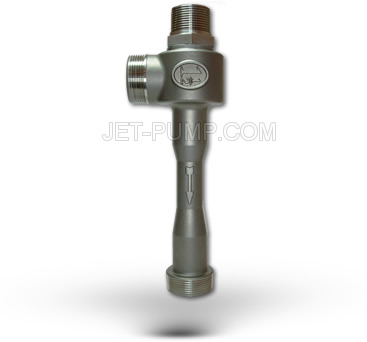Inline Steam Jet Heaters
 Steam jet heaters optimize the condensing of steam into operating liquids to provide efficient fluid heating. They essentially are jet pumps, and as such, operate on the principle of one fluid entraining a second fluid.
Steam jet heaters optimize the condensing of steam into operating liquids to provide efficient fluid heating. They essentially are jet pumps, and as such, operate on the principle of one fluid entraining a second fluid.
Steam jet heaters have three common features (designations may vary according to design): inlet, suction and discharge.
Inlet – The operating liquid (some-times called the Motive) under pressure enters the inlet and travels through the nozzle into the suction chamber. The nozzle converts the pressure of the operating liquid into a high velocity stream, which emerges from the discharge side of the inlet nozzle.
Suction – Pumping action begins when steam in the suction chamber is entrained by the high velocity operating liquid stream emerging from the inlet nozzle, lowering the pressure in the suction chamber. The resulting action causes the steam in the suction chamber to flow toward the discharge.
Discharge (sometimes called Outlet) – The entrained steam n the suction chamber mixes and condenses into the operating liquid and acquires part of its energy, flowing into the parallel section. In the diffuser section, part of the velocity of the mixture is converted into a pressure greater than the suction pressure, but lower than the inlet pressure.
Stream jet heater operation Several types of Steam Jet Heaters are available. Although their designs vary, the operation of each is based on the jet operating principles of the jet pump.
Typically, a steam jet heater includes an inlet for the liquid to be heated, a steam inlet (suction) where steam is introduced under pressure, and a discharge where the heated liquid and condensed steam leave the heater. (These correspond to the inlet, suction and discharge of a jet pump.)
The advantages of using steam jet heaters for heating liquids Steam Jet Heaters offer many advantages:
- They have no moving parts, nothing to break or wear.
- There are no packing glands.
- No lubrication is required.
- The initial cost is low.
- Installation cost is low because they are compact and no foundation or wiring is necessary.
- They provide reliable operation with low maintenance cost.
Steam jet heater applications There are numerous possible applications for Steam Jet Heaters. Heaters are available for heating liquids in line or in a tank. Steam Jet Heaters are commonly found in these industries: food processing, petroleum, dairy, manufacturing, chemical, distilling/brewing, and others.
Specific applications for inline heaters include: circulating cleaning solutions, pasteurization, producing scalding sprays, sterilization, heating water, blanching, exchanging heat, degreasing, heating slurries, laundering, cooking, pickling, bonderizing, quenching and tempering.
Specific applications for open tank heaters include cooking grain, cooking mash, cooking starch, heating and circulating, mixing.

